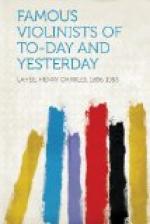Paganini won another violin by his ability to read music at sight. Pasini, an eminent painter and an amateur violinist, refused to believe the wonderful faculty for playing at sight, which had been imputed to Paganini, and in order to test it brought him a manuscript concerto containing some difficulties considered as insurmountable. “This instrument shall be yours,” said Pasini, placing in his hands an excellent Stradivari, “if you can play, in a masterly manner, this concerto, at first sight.” Paganini accepted the challenge, threw Pasini into ecstasies, and became the owner of the instrument.
The severe course of dissipation in which Paganini indulged during these days of his youth ruined his health, and caused him frequently to disappear from the public gaze for long periods, throughout his career. With the fair sex he had more than one romantic episode. At one time a lady of high rank fell in love with him and led him captive to her castle in Tuscany. Here the lovers solaced themselves with duets on the guitar, and the violinist attained a proficiency, on that instrument, equal to the expression of the tenderest passion. This adventure brought retribution in after days, and in a most unexpected manner, for as his genius began to excite the wonder of the world, sundry malicious stories concerning him were invented and circulated. One of these stories was to the effect that he had been imprisoned for stabbing one of his friends, another rumour said that he strangled his wife, and that during his imprisonment he had been allowed only the solace of playing his violin with but one string. This story was told in order to account for his wonderful one-stringed performances, and it was absolutely untrue, but the time allotted by rumour to his supposed imprisonment coincided with the period which was really occupied with this romance.
At the end of three years he resumed his travels and his violin playing, returning to Genoa in 1804, where he set to work on some compositions. At this time he became interested in a little girl, Catarina Calcagno, to whom he gave lessons on the violin. She was then about seven years of age, and a few years later she became well known as a concert violinist.
Paganini did not remain long in Genoa, for the following year found him wandering again, and another love affair in Lucca led to the composition of a piece to be played on two strings, the first and the fourth: the first to express the sentiments of a young girl, and the fourth the passionate language of her lover. The performance of this extremely expressive composition was rewarded by the most languishing glances from his lady-love in the audience, but the most important result was that the Princess Elise Bacchiochi, sister of Napoleon, declared to him that he had performed impossibilities. “Would not a single string suffice for your talent?” she asked. Paganini was delighted, and shortly afterward composed his military sonata entitled “Napoleon,” which is performed on the G string only.




